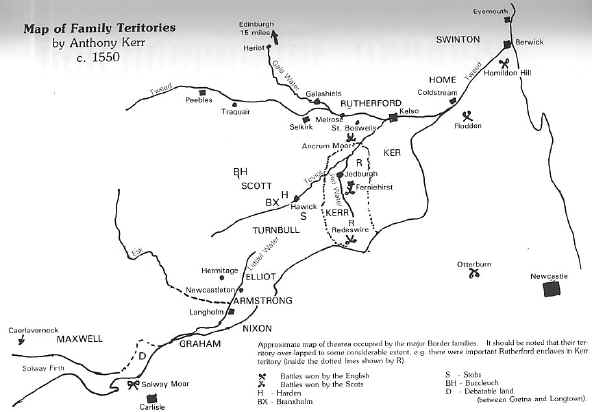|
"Clan Maps" and
"Tartan Maps" of Scotland typically show surnames splashed
across areas of varying extent, each with its own distinctive colour.
This is a gross oversimplification so far as the South of Scotland is
concerned, though it may have been valid for some parts of the Highlands
until 1745.
In reality there would
have been no area where everybody was called Kerr and owed allegiance to
Ferniehirst; any more than there was an area where everybody was called
Scott and owed allegiance to Buccleuch. Things were a lot more complex,
and allegiance was not a straightforward matter of "one man, one
Lord" — certainly not in the period we are considering.
In the first place, Kerrs,
Scotts, Elliots, Rutherfords, Turnbulls and others were inextricably
mixed throughout the Central Borders, though in varying proportions from
place to place. They were also inextricably intermarried, and with the
considerable number of men killed in battle, in raids or on the scaffold
at a fairly early age, it was not unlikely that their sons might be
brought up by a maternal uncle with another surname and form strong
links with his family.
Secondly, the same
individual often held various bits and pieces of land from different
"superiors", owing allegiance to each of them for the relevant
property. (This gave rise to problems if they fought each other, as
often happened.)
Thirdly two landowners,
not necessarily "superior" and "vassal", but quite
possibly equals who found it useful to co-operate, could be linked by a
"bond of man-rent" and it was quite feasible for the same
individual to have this type of relationship (basically a mutual
protection agreement, as we have seen) with several others, who again
might choose to fight each other.
"Kerr
territory" was therefore the area where the Laird of Ferniehirst
could call out more men than anyone else, rather than a vast tract of
land which he actually owned. Many of them could also be called out by
Scott of Buccleuch or Rutherford of That Ilk, for instance, and the
reverse of course applied. Subject to this reservation, and with all the
uncertainty this implied, it extended roughly from Lilliards Edge to
Carter Bar and frog Crailing to Denholm, with outlying pockets further
north and west. There were also Kerrs in Ayrshire and Stirlingshire
(among other areas). but Ferniehirst could not usefully have called them
out, as any giver emergency would have been long since past when they
showed up "late but in earnest".

|

